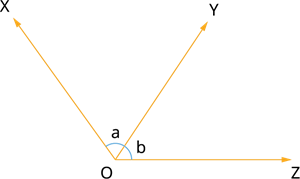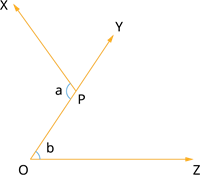UPSKILL MATH PLUS
Learn Mathematics through our AI based learning portal with the support of our Academic Experts!
Learn moreExamine the images below and observe the angles you can find in both the book and the clock.

You can find two angles in the book close to each other and two angles in the clock close to each arm of the clock.
Definition:
Any two angles are called adjacent angles when they have a common vertex and a common arm.
In the case of the book, 'papers in the middle' forms the common arm, and in the clock, the 'hour hand' acts as a common arm.
Now, study the diagram below showing adjacent angles.

In the diagram, \(O\) is the common vertex, and \(OY\) is the common arm.
\(\angle XOY\) and \(\angle YOZ\) are the adjacent angles.
The non-common arms are on either side of the common arm.
Example:
Do the angles \(a\) and \(b\) in the figure form adjacent angles. If not, state the reason.

Solution:
From the figure, we observe that the angles \(a\) and \(b\) have no vertex in common.
Also, the two angles \(\angle XPO\) \(=\) \(a\) and \(\angle YOZ\) \(=\) \(b\) have no common arm.
Thus, the given angles do not satisfy the properties of adjacent angles.
Therefore, the angles \(a\) and \(b\) in the figure do not form adjacent angles.